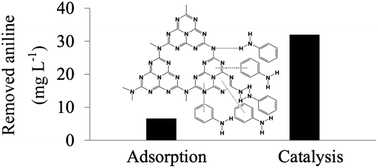Mesoporous carbon nitride as a metal-free catalyst for the removal of aniline†
Abstract
Mesoporous carbon nitride (MCN) was used for the first time as a thermal catalyst for the removal of aniline. While bulk carbon nitride (BCN) and mesoporous silica (MCM-41) did not show any catalytic activities, the MCN showed aniline removal (33%) at 398 K. It was revealed that the much higher activity of the MCN originated from the presence of mesoporosity and suitable adsorption sites for the reaction to occur. The nature of aniline adsorption on MCN was found to fit well to the Freundlich adsorption model. The evidence on the interactions between aniline and MCN was supported by fluorescence and FTIR spectroscopies. It was suggested that the interactions between MCN and aniline involved both weak π to π stacking and strong hydrogen bonding, which were important to initiate the catalytic removal of aniline.


 Please wait while we load your content...
Please wait while we load your content...